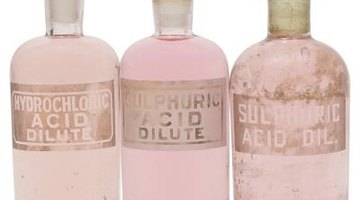Why Does Copper Turn Green in HCL?
Copper (II) ions have lost two electrons and hence have a +2 charge. If you have copper (II) ions in solution and add concentrated hydrochloric acid, the solution turns green in color. Dilute the solution in water again and it turns light blue. These striking changes hint at the remarkable chemistry of transition metals -- chemistry that helps explain many of the colors you see around you in your everyday life.
Color

Why do any of the objects you see have color? It's because they reflect or transmit certain colors of light but not others. If an object reflects all colors of light it appears white, and if it transmits all colors of light, it appears translucent or transparent. When concentrated hydrochloric acid is added to a solution of copper (II) ions, it's forming a copper (II) chloride complex; this complex appears green because it absorbs red light.
Energy
Light is energy in the form of electromagnetic radiation. The energy of a photon or particle of light is determined by its frequency; higher frequencies mean higher energies and vice versa. Red light has the lowest frequency of light in the visible spectrum, while violet light has the highest frequency. A molecule or complex ion like the one formed by copper and chloride can only absorb photons of light with energy equal to the difference between the molecule/ion's current state and an "excited state" it can occupy. Consequently, the difference between available energy levels for molecules/ions in a substance determines what colors of light it will absorb and what color it appears to be.
Complex Ion
Initially, in the water solution, copper has six water molecules bound to it; these water molecules approach from six different directions, so they form an octahedral complex. (Take a look at the pictures under the Resources section to see what this looks like.) The electrons on the metal atom can exist in regions called orbitals. The outermost orbitals of the metal ion are d-type orbitals, and there are 6 of them. Electrons are negatively charged and repel each other, so an electron in some of the metal ion's d-orbitals will have a higher energy than an electron in others, because some of the orbitals point directly at the directions along which the water molecules approach.
Absorption
The difference in energy between the high-energy d-orbitals of the metal ion and the low-energy d-orbitals tells us what frequency of light the complex will absorb. This difference is called the field splitting. Some molecules/ions cause a large field splitting than others, and in fact molecules/ions that bind to metal ions can be ranked according to the field splitting they cause along what's known as the spectrochemical series. Chloride is lower along the spectrochemical series than water, and the copper-chloride complex also has a different geometry, so when the chloride ions displace the water molecules to form the copper-chloride complex, the field splitting decreases. That's why the copper chloride complex absorbs low-energy red light and appears green, while the copper-water complex absorbs higher energy yellow-orange light and appears blue.
References
- ChemGuide UK: Copper
- Purdue University: Transition Metal Complexes
- "Chemical Principles, the Quest for Insight, 4th Edition"; Peter Atkins and Loretta Jones; 2008
- Georgia State University Hyperphysics: Quantum Properties of Light
- DePaul University: THe Spectrochemical Series
Resources
Writer Bio
Based in San Diego, John Brennan has been writing about science and the environment since 2006. His articles have appeared in "Plenty," "San Diego Reader," "Santa Barbara Independent" and "East Bay Monthly." Brennan holds a Bachelor of Science in biology from the University of California, San Diego.
Photo Credits
- Hemera Technologies/PhotoObjects.net/Getty Images
More Articles



